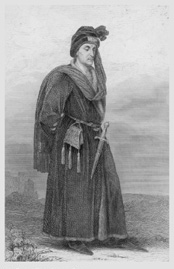The Good, the Bad and the Unready (21 page)
Read The Good, the Bad and the Unready Online
Authors: Robert Easton

 John the
John the
Fearless
John, duke of Burgundy, 1371–1419
John received his epithet from his exploits at the battle of Nicopolis against the Ottoman Turks. A cursory examination of his actions there, however, might lead one to think that he should have been dubbed not ‘the Fearless’ but ‘the Stupid’.
In 1396 European powers were laying siege to the main Turkish stronghold on the Danube. Sigismund the
LIGHT OF THE WORLD
, the organizer of the crusade, urged prudence, but the knights ignored this sage advice and, with John at the vanguard, charged up the steep hill to the fortified town. Although they scattered the first line of Turkish cavalry and infantry, they were no match for the second wave of defence and, exhausted from
the climb, most of the knights were cut down. John somehow survived to fight another day.

John the
Fearless
The son of Philip the
BOLD
, John was a little man with a big head and eyes like a frog. According to chronicler Olivier de la Marche, he was ‘very courageous’ but trusted no one and ‘always wore armour under his robe’. Indeed, this man who regularly used assassination as a political tool lived in absolute fear of his own murder, making his nickname ‘Sans Peur’ a mockery of reality.
And murdered he was. In 1419 he and some Burgundian delegates met on a bridge at Montereau near Paris to sign a peace treaty with counterparts from Armagnac. John walked into a covered enclosure, where his armour could not withstand a torrent of blows from battleaxes.
 Alfonso the
Alfonso the
Fierce
Alfonso IV, king of Portugal, 1291–1357
Alfonso may have been fierce and brave (several chroniclers refer to him as ‘Afonso o Bravo’), but his reign was marked by austerity rather than ferocity. The son of Denis the
FARMER
(
see
NOBLE PROFESSIONS
), Alfonso continued where his father had left off in strengthening royal authority and promoting justice, but numerous internal revolts and the devastating impact of the Black Death, which claimed at least a third of Portugal’s population, left a country weakened and politically unstable. Alfonso deemed it necessary to use severe methods to quash domestic
dissent, and it is from these actions that he probably earned his nickname.
Another origin of the name could be the manner in which he treated Ines de Castro, the mistress of Peter the
CRUEL
, his son and heir. Ines was a Galician and, concerned that her brothers would direct the affairs of Portugal rather than his son, Alfonso went to her estate in early 1355 to talk to her and assess the situation. After a seemingly amicable interview he rode nonchalantly away, while a couple of his hired hands stayed behind and murdered her.
 James the
James the
Fiery Face
James II, king of Scotland, 1430–60
As his nickname implies, the most obvious thing about James was his disfigurement, and in Francois Villon’s
Ballade
the left half of his face is described as ‘the colour of an amethyst from the forehead to the chin’. No poetic licence was in operation here: a contemporary drawing provides visual evidence to support the French lyric poet’s claim.
James was fiery in appearance and fiery by nature. An uneasy truce with the powerful Douglas family ended when James stabbed William, the eighth earl, to death and demolished the clan’s castles. Then, with Scotland mostly under his sway, he turned his attention to England, but died while laying siege to Roxburgh Castle.
 Ptolemy the
Ptolemy the
Flute Player
see
PTOLEMAIC KINGS
 Lulach the
Lulach the
Fool
Lulach, king of Scotland, c.1031–58
When Macbeth was cut down by the forces of Malcolm
BIGHEAD
, Lulach, Macbeth’s stepson, found himself king. By styling him
‘the Fool’ or ‘the Simpleton’ chroniclers suggest that he was not up to the task at all. His entire sorry reign was spent battling with Malcolm
BIGHEAD
, and he was killed in an ambush in Strathbogie some four months after his coronation.
 Louis the
Louis the
Foreigner
Louis IV, king of France, 921–54
When his father ‘Charles the Simple’ was deposed from the French throne, Louis’s mother Eadgifu whisked Louis off to England where he grew up in the court of Athelstan the
GLORIOUS
. After thirteen quiet years away from France, for which he was dubbed ‘the Foreigner’ or ‘d’Outremer’, Louis returned home to a torrid battle for supremacy, not least with the forces of such luminaries as ‘Otto the Great’ and ‘Hugh the Great’ (
see
GREAT… BUT NOT THAT GREAT
).
 Sven
Sven
Forkbeard
Sven I, king of Denmark and England, c.960–1014
With an imposing hairstyle to match his imposing North Sea empire, Sven, the son of Harald
BLUETOOTH
, instigated a mass of incursions against England. The onslaught then intensified when Ethelred the
UNREADY
ordered the killing of every Dane living in England, in what has come to be known as the St Brice’s Day Massacre of 1002. Some scholars think that Sven’s sister Gunhilda was one of the victims.
Battered by successive punitive expeditions and ineptly governed, England was ripe for conquest, and on Christmas Day 1013 Sven was pronounced her king. He didn’t live long to wallow in royal glory, however. Just six weeks later the great Viking warrior toppled from his horse and died.
 Manuel the
Manuel the
Fortunate